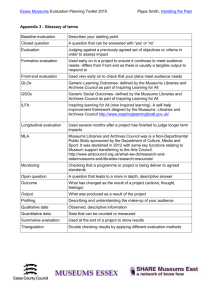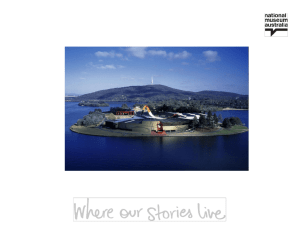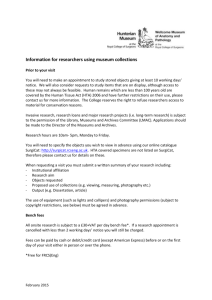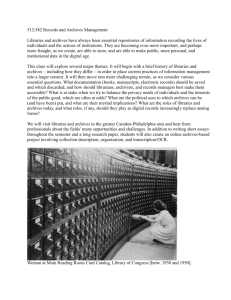Alan Knox – Museums and Archives
advertisement
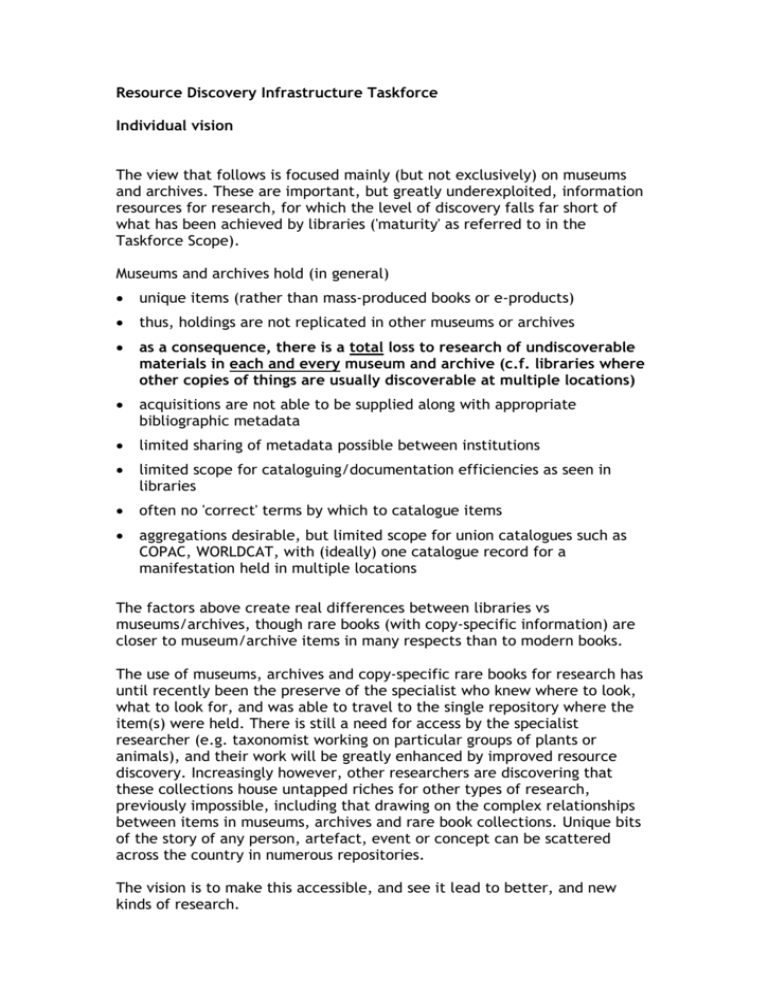
Resource Discovery Infrastructure Taskforce
Individual vision
The view that follows is focused mainly (but not exclusively) on museums
and archives. These are important, but greatly underexploited, information
resources for research, for which the level of discovery falls far short of
what has been achieved by libraries ('maturity' as referred to in the
Taskforce Scope).
Museums and archives hold (in general)
unique items (rather than mass-produced books or e-products)
thus, holdings are not replicated in other museums or archives
as a consequence, there is a total loss to research of undiscoverable
materials in each and every museum and archive (c.f. libraries where
other copies of things are usually discoverable at multiple locations)
acquisitions are not able to be supplied along with appropriate
bibliographic metadata
limited sharing of metadata possible between institutions
limited scope for cataloguing/documentation efficiencies as seen in
libraries
often no 'correct' terms by which to catalogue items
aggregations desirable, but limited scope for union catalogues such as
COPAC, WORLDCAT, with (ideally) one catalogue record for a
manifestation held in multiple locations
The factors above create real differences between libraries vs
museums/archives, though rare books (with copy-specific information) are
closer to museum/archive items in many respects than to modern books.
The use of museums, archives and copy-specific rare books for research has
until recently been the preserve of the specialist who knew where to look,
what to look for, and was able to travel to the single repository where the
item(s) were held. There is still a need for access by the specialist
researcher (e.g. taxonomist working on particular groups of plants or
animals), and their work will be greatly enhanced by improved resource
discovery. Increasingly however, other researchers are discovering that
these collections house untapped riches for other types of research,
previously impossible, including that drawing on the complex relationships
between items in museums, archives and rare book collections. Unique bits
of the story of any person, artefact, event or concept can be scattered
across the country in numerous repositories.
The vision is to make this accessible, and see it lead to better, and new
kinds of research.
(Meta)data in museums and archives
Make all existing data accessible
Improve the amount of material catalogued
Increase the amount available digitally
Documentation (cataloguing) of museum and archive collections falls far
short of the level seen in libraries. Before museum and archive metadata
can be aggregated, it has to be created. While the first step should be to
make accessible existing data on collections, a major investment will be
required to increase the proportion of collections properly catalogued.
This is not to suggest everything should be item-level catalogued. The
archives community understands the need to determine the proper level
of cataloguing for each collection, many of which are adequately
described in Collection Level Descriptions, whereas others should be
taken to the item level. The hierarchical nature of archive collections
lends itself to this, but in most museum collections the fit is less good.
There is a need to extend this thinking in museums, and to improve
systems, standards and training for the creation of CLDs and useful bulk
catalogue records.
How to take this forward:
Existing (meta)data For larger collections, facilitate OAI-enabling of collections
management systems/databases [estimate funding of ~£2k per
collection where needed; funding for museums could be distributed
through existing regional museums agencies]
For smaller collections (e.g. small independent museums), facilitate
access to their cataloguing data with the help of larger regional
partners (probably the Hubs in England; no comparable structures in
Scotland, though RDCF partnerships may provide a working base, or
the universities) [relatively low costs involved]
Aggregate museum data through e.g. People's Network Discover
System (PNDS) [the only system currently offering access to CLDs and
item-level information] or similar, as well as Google and specialist
portals [low costs involved]
Aggregate archives data through e.g. the Archives Hub, but extend to
all archive repositories (Archives Hub currently largely restricted to
academic archives)
Examine how best to converge search systems covering libraries,
archives and museums
The SFC-funded SPIRIT Revealing the Hidden Collections project
involving 9 Scottish universities (led by Aberdeen) may provide a
useful model for some of these mechanisms as they relate to
museums
Improving levels of cataloguing/documentation The central recommendation would be to initiate a programme of
funding for priority museum cataloguing projects (CLD and item-
level), along the lines of RSLP (libraries and archives both benefitted
from the original RSLP programmes) [significant costs]
Also, creating images for priority collections of museum items and
digitising key archives; IPR issues to be addressed [significant costs]
Discovery Discourage proliferation of portals offering access to unique data sets
(i.e. encourage high-level aggregation [by harvesting], supplemented
by customised gateways for specialised sub-sets/audiences, though
all data should be available through the high-level aggregation)
[no/limited cost]
Encourage full access to datasets by search engines
Encourage mechanisms for incorporating researcher information into
museum/archive databases, as quality additions to existing records,
with hyperlinks as appropriate [limited direct cost]
Encourage systems suppliers to enhance search functionalities
(including faceted searching, tagging) [limited direct cost, though
cost to software suppliers]
Support mechanisms to develop and/or enhance authority control
within and across museums, archives and libraries [moderate cost]
Perhaps most importantly for enhancing discovery: support central or
dispersed mechanisms to overcome the diversity in cataloguing
terminology and approaches - e.g. web-scale developments to
incorporate (e.g.) o geospatial data
o thesauri
o 'users who searched for x also searched for y'
o mechanisms to search for patterns of relevant adjacency in
terms within records (e.g. 'Jacobite' and 'Stewart')
and build these into ranked search mechanisms [moderate cost]
Further investment is clearly required in library resource discovery as
well, but the funding of further retrocataloguing will bring only
incremental progress.
For step changes in access, funding should be targeted to museums,
archives and copy-specific rare books, to open new areas of research.
The proposals above are achievable with adequate funding, and using
technologies that already exist (mostly) but just need brought together.
